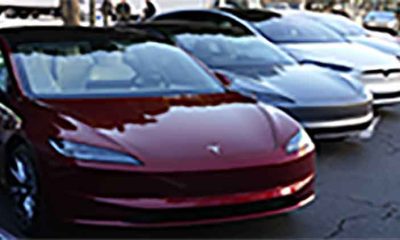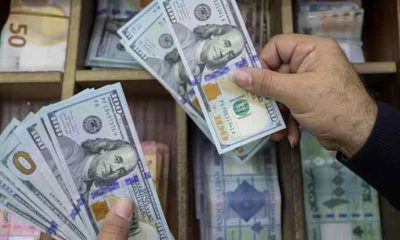Tech
China-Europe rivalry heats up at Paris car show as EV tariffs loom

Chinese and European automakers went head-to-head at the Paris car show on Monday, with tensions running high as the EU gears up to impose hefty import tariffs on Chinese-made electric vehicles and the industry struggles with weak demand.
This year’s event – the largest car show in Europe – comes at a pivotal time. Struggling European automakers need to prove they are still in the game, while Chinese rivals are aiming to get a foothold in a competitive market.
There was some common ground, though, with executives from both regions warning about the dangers of EU tariffs.
Nine Chinese brands including BYD and Leapmotor are unveiling their latest models at this year’s event, according to Paris auto show CEO Serge Gachot. That is the same as in 2022 when they made up almost half the brands present.
This year, they account for only about a fifth of the brands thanks to a much stronger showing from Europe’s auto industry – a sign of its determination to defend its home turf.
Earlier this month, EU member states narrowly backed import duties on Chinese-made EVs of up to 45%, meant to counter what Brussels says are unfair subsidies from Beijing to Chinese manufacturers. Beijing denies unfair competition and has threatened counter-measures.
While Chinese automakers have criticised the EU’s move, they are pressing ahead with European expansion plans and so far none has said it will raise prices to cover the duties.
Chinese EV makers like BYD have so far priced their vehicles slightly below European rivals, giving them an advantage. That will also help offset lower margins at home. Like Japanese and South Korean automakers before them, they are also touting better equipment and offering more features as standard.
Yet even BYD, which already sells EVs across much of Europe and sponsored the European soccer championships this summer, still has relatively low brand recognition, so hopes to make a splash with the electric Sea Lion 07 SUV it is launching.
The pressure is on to try to keep prices down in Europe too, as EV makers try to close the gap with cheaper gasoline cars.
“My personal view is we will achieve price parity in Europe in 2-3 years. Everybody, if you want to compete, you need to work hard towards that goal,” said Leapmotor International CEO Tianshu Xin.
China’s passenger vehicle sales rose 4.3% in September from a year ago, snapping five months of decline with a boost from a government subsidy to encourage trade-ins as part of a broader stimulus package. Europe’s sales hit a three-year low in August.
In another blow to the EV market, the French government said on Thursday it would reduce its support for EV buyers, joining Germany which ended its subsidy scheme late last year.
The stacked bar chart shows the share of new car registrations in the EU between January and August 2023 and 2024 by fuel type.
‘ALARM BELLS’
Chinese automakers also need to do well in Europe because they have been shut out of the U.S. market.
Stellantis’ Tavares on Monday declined to rule out job cuts or offloading brands.
“We will need to make big efforts”, he said, adding it was up to customers to decide which brands had a future.
Volkswagen is also locked in a battle with powerful unions over cost cuts that could see it close German factories for the first time and cut thousands of jobs.
The Europeans are struggling to compete with Chinese rivals’ lower costs and their ability to develop new EVs in just two years, at least twice as fast as traditional Western automakers.
“The Europeans have massive alarm bells ringing,” Stax’s Dunne said. “They have recognised they need to do something pretty radical and they only have a couple of years to do it.”
Tech
OpenAI, SoftBank each commit 19bn dollars to Stargate AI data center

OpenAI and Japanese conglomerate SoftBank (9984.T) will each commit $19 billion to fund Stargate, a joint venture to develop data centers for artificial intelligence in the U.S., the Information reported on Wednesday.
The ChatGPT maker will hold a 40% interest in Stargate, and would act as an extension of OpenAI, the report said, citing OpenAI CEO Sam Altman speaking to colleagues. His comments imply SoftBank would also have a 40% interest, the report added.
OpenAI and SoftBank did not immediately respond to Reuters’ requests for comment.
On Tuesday, U.S. President Donald Trump announced that OpenAI, SoftBank Group and Oracle (ORCL.N) will unveil Stargate and invest $500 billion over the next four years to help the United States stay ahead of China and other rivals in the global AI race.
Stargate will initially deploy $100 billion and the rest of the funding is expected over the next four years. The project is being led by SoftBank and OpenAI.
Tech
Taiwan’s HTC to sell part of XR unit to Google for 250mn dollars

Taiwan’s HTC (2498.TW) said on Thursday it will sell part of its unit for extended reality (XR) headsets and glasses to Google (GOOGL.O) for $250 million and transfer some of its employees to the U.S. company.
The transaction is expected to close in the first quarter of this year, HTC said.
The two companies will also explore further collaboration opportunities, HTC added.
Google said in a separate statement that the deal will accelerate the development of the Android XR platform and strengthen the ecosystem for headsets and glasses.
Lu Chia-te, HTC vice president and general counsel, told reporters the company had granted its intellectual property rights to Google as a non-exclusive license.
“Therefore, this is not a buyout nor an exclusive licence. In the future, HTC will still retain the ability to use, utilise, and even further develop it without any restrictions,” he said.
Tech
Microsoft’s LinkedIn sued for disclosing customer information to train AI models

Microsoft’s (MSFT.O) LinkedIn has been sued by Premium customers who said the business-focused social media platform disclosed their private messages to third parties without permission to train generative artificial intelligence models.
According to a proposed class action filed on Tuesday night on behalf of millions of LinkedIn Premium customers, LinkedIn quietly introduced a privacy setting last August that let users enable or disable the sharing of their personal data.
Customers said LinkedIn then discreetly updated its privacy policy on Sept. 18 to say data could be used to train AI models, and in a “frequently asked questions” hyperlink said opting out “does not affect training that has already taken place.”
This attempt to “cover its tracks” suggests LinkedIn was fully aware it violated customers’ privacy and its promise to use personal data only to support and improve its platform, in order to minimize public scrutiny and legal fallout, the complaint said.
The lawsuit was filed in the San Jose, California, federal court on behalf of LinkedIn Premium customers who sent or received InMail messages, and whose private information was disclosed to third parties for AI training before Sept. 18.
It seeks unspecified damages for breach of contract and violations of California’s unfair competition law, and $1,000 per person for violations of the federal Stored Communications Act.
A lawyer for Prince Harry on Wednesday said the Duke of Sussex had reached a settlement with Rupert Murdoch’s news conglomerate.
LinkedIn said in a statement: “These are false claims with no merit.”
A lawyer for the plaintiffs had no immediate additional comment.
The lawsuit was filed several hours after U.S. President Donald Trump announced a joint venture among Microsoft-backed OpenAI, Oracle (ORCL.N) and SoftBank (9984.T), with a potential $500 billion of investment, to build AI infrastructure in the United States.
-

 Business2 months ago
Business2 months agoAuto industry’s shift toward EVs is expected to go on despite Trump threat to kill tax credits
-

 Entertainment3 months ago
Entertainment3 months agoBeyoncé leads the 2025 Grammy noms, becoming the most nominated artist in the show’s history
-

 pakistan3 months ago
pakistan3 months agoPM Shehbaz terms promotion of foreign investment as top priority
-

 Business3 months ago
Business3 months agoWall Street cruises toward the close of its best week in a year
-

 World2 months ago
World2 months agoSix Israeli troops killed, deadly strikes in Lebanon
-

 Entertainment2 months ago
Entertainment2 months agoMovie Review: ‘Red One’ tries to supersize the Christmas movie
-

 Business2 months ago
Business2 months agoWall Street gains ground as it notches a winning week and another Dow record
-

 Sports1 month ago
Sports1 month agoSouthampton set to sign Juric as new manager

















